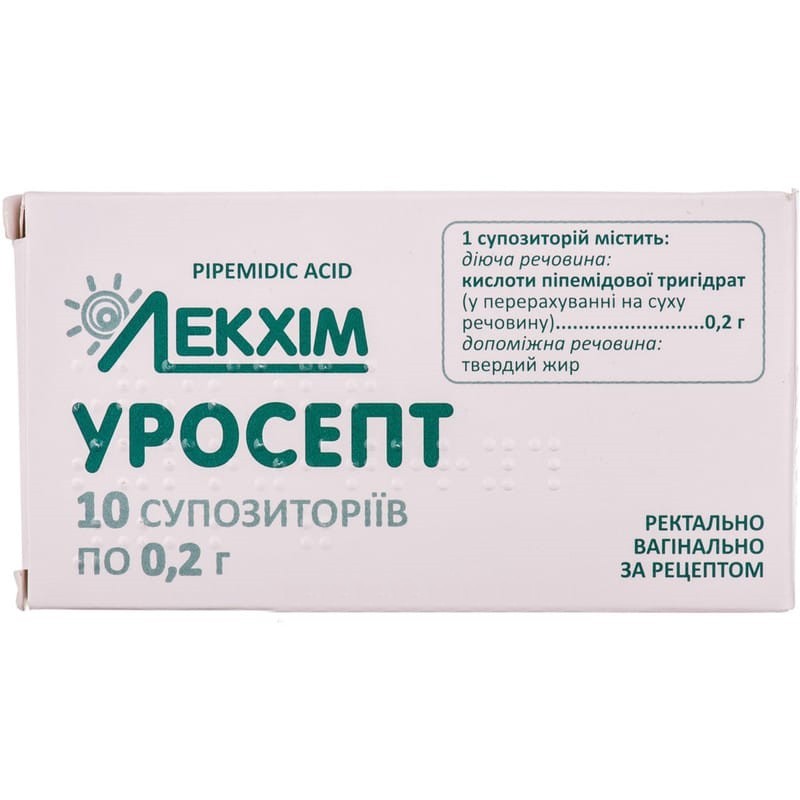



 Secure and encrypted payment processing
Secure and encrypted payment processing We ship to over 40 countries including the USA, UK, Europe, Australia and Japan
We ship to over 40 countries including the USA, UK, Europe, Australia and Japan Guaranteed refund or reship if you haven't received your order
Guaranteed refund or reship if you haven't received your orderActive ingredient: pipemidic acid;
1 suppository contains pipemidic acid trihydrate in terms of dry substance 0.20 g (200 mg);
excipient: solid fat.
Suppositories.
The main physico-chemical properties: suppositories of white or yellowish-white color, bullet-shaped. The presence of plaque on the surface of the suppository is allowed.
Antibacterial agents of the quinolone group.
ATX code is J01M B04.
Pharmacodynamics
Uroantiseptic of the quinolone series. It is bactericidal, active against most gram-negative microorganisms, as well as against some gram-positive microorganisms, in particular Staphylococcus aureus.
Pharmacokinetics
The maximum concentration of the drug in blood plasma is determined 2-3 hours after use and coincides in time with the maximum concentration of the drug in the urine. Excreted by the kidneys unchanged.
Infectious and inflammatory diseases caused by microorganisms sensitive to pipemidic acid, including pyelonephritis, urethritis, cystitis, prostatitis, nonspecific colpitis.
Hypersensitivity to pipemidic acid, quinolones or any other components of the drug. severe renal impairment (creatinine clearance less than 10 ml / min), severe hepatic impairment. cirrhosis of the liver, porphyria. diseases of the central nervous system (epilepsy, neurological conditions with a reduced convulsive threshold).
With prolonged use of pipemidic acid, the half-life of theophylline is prolonged, so its concentration in the blood serum increases by 40–80%. therefore, in patients taking theophylline, its serum level should be monitored more often.
Quinolones increase the serum concentration of caffeine; pipemidic acid can provide a coefficient of increase from 2 to 4.
The drug can enhance the effect of warfarin, rifampicin, cimetidine with their simultaneous use.
The simultaneous use of quinolones and non-steroidal anti-inflammatory drugs increases the risk of seizures.
Antacids (preparations of aluminum, magnesium and calcium) and sucralfate significantly reduce the absorption of pipemidic acid, so they should not be prescribed at the same time. The interval between injections of these drugs should be 2-3 hours. However, this effect was not observed with simultaneous use with cimetidine and ranitidine.
With aminoglycosides, a synergistic bactericidal effect occurs.
During treatment, patients should take plenty of fluids.
In single cases, Urosept can cause seizures, therefore, for patients with epilepsy and other neurological diseases with a reduced seizure threshold, treatment is contraindicated.
Due to the risk of acute porphyrin crisis, treatment of patients with porphyria is contraindicated.
Caution is advised to prescribe the drug to patients over the age of 70 years, since side effects in elderly people were observed more often.
The patient should be warned about the need to avoid direct sunlight and artificial ultraviolet radiation during treatment with pipemidic acid due to possible photosensitivity.
Superinfection caused by persistent bacteria and fungi may develop.
With caution, the drug should be used in the treatment of patients with a deficiency of glucose-6-phosphate dehydrogenase, since quinolones can cause acute hemolytic crisis.
With prolonged treatment with pipemidic acid, pseudomembranous colitis may develop, therefore, in case of diarrhea in the patient, appropriate measures should be taken.
Treatment with pipemidic acid can alter the intestinal flora, resulting in an increase in the number of Clostridum difficile bacteria, and, accordingly, pseudomembranous colitis may develop.
In adolescents, taking the drug can affect temporary cartilage, so the use of pipemidic acid is contraindicated in children under the age of 18 years.
Allergic reactions often occur in individuals with hypersensitivity to acetylsalicylic acid.
Laboratory tests. A false-positive reaction to glucose in the urine may be observed.
The drug is contraindicated for use during pregnancy or breastfeeding.
When using the drug, one should refrain from driving vehicles or working with other mechanisms, as dizziness and visual impairment are possible (see the section “Adverse Reactions”).
Before applying the suppository, you must:
Apply 1 suppository vaginally or rectally 2 times a day for 10 days. If necessary, the daily dose should be increased to 3 suppositories, i.e. 1 suppository 3 times a day.
The drug should not be used to treat children.
Symptoms: nausea, vomiting, dizziness, headache, confusion, tremors and cramps.
Treatment. If the patient has not lost consciousness as a result of taking a large amount of the drug, it is recommended to induce vomiting, rinse the stomach and prescribe activated charcoal.
Pipemidic acid is excreted by hemodialysis (90% in 6 hours).
If side effects from the central nervous system (including epileptiform convulsions) occur, prescribe symptomatic treatment (diazepam).
Local reactions: irritation, pain, itching at the injection site.
Systemic reactions:
on the part of the blood and lymphatic system: eosinophilia is rarely possible, and in elderly patients and patients with impaired renal function, reverse thrombocytopenia was observed. In individuals with a deficiency of glucose-6-phosphate dehydrogenase hemolytic anemia is possible;
mental disorders: agitation, depression, confusion, hallucinations;
from the nervous system: tremor, sleep disturbances, sensory disturbances, dizziness; very rarely - cramps, vertigo, headache;
on the part of the organs of vision: visual impairment;
on the part of the skin and subcutaneous tissues: hypersensitivity reactions, which include skin rashes, itching, photosensitivity, Stevens-Johnson syndrome; rarely - angioedema. Skin reactions are reversible. There are reports of the development of anaphylactic reactions. Due to the possibility of cross-sensitivity to other quinolones, caution is required in treating patients who have had an anaphylactic reaction to any quinolone;
from the musculoskeletal system: acute arthropathy, tendonitis.
from the gastrointestinal tract: anorexia, epigastric pain, heartburn, nausea, vomiting, flatulence, abdominal pain, diarrhea or constipation; rarely - pseudomembranous colitis;
others: rarely - weakness, development of resistance, superinfection.
If signs of hypersensitivity reactions, anaphylactic shock, toxic epidermal necrolysis, or seizures occur, treatment should be stopped immediately.
3 years.
Keep out of the reach of children.
Store in the original packaging at a temperature not exceeding 25 ° C.
5 suppositories in a blister, 2 blisters in a pack.
On prescription.
Private joint-stock company "lekkhim-kharkov".
Ukraine, 61115, Kharkiv region, Kharkiv city, Severin Pototsky street, 36.